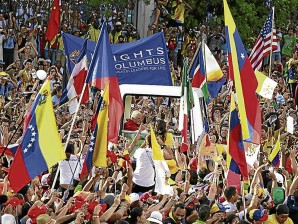
WORLD YOUTH DAY IN MADRID Pope Benedict XVI (center) waves from the popemobile at the people crowding Madrid’s Cibeles square on Thursday for the formal opening of the four-day festivities. It was also to welcome the Pope who arrived in Spain that day. He told the youths of the world that their faith is all the more important in modern society where there’s “a certain eclipse of God” taking place. AP
MADRID—Pope Benedict XVI lamented on Friday what he called modern society’s “amnesia” about God as he traveled to a famed Spanish monastery on the second day of his four-day visit for the Church’s world youth festival.
Several hundred young nuns cheered, waved flags and performed the “wave” at El Escorial monastery as they waited for Benedict inside a courtyard of the 16th-century complex, a Unesco world heritage site about 50 kilometers northwest of the capital.
Benedict told them their decisions to dedicate their lives to their faith was a potent message in today’s increasingly secular world.
“This is all the more important today when we see a certain eclipse of God taking place, a kind of amnesia which albeit not an outright rejection of Christianity is nonetheless a denial of the treasure of our faith, a denial that could lead to the loss of our deepest identity,” he said.
Pious roots
Benedict’s main priority as Pope has been to try to reawaken Christianity in places like Spain, a once staunchly Catholic country that has drifted far from its pious roots.
He has traveled here three times as Pope, an indication that he views it as the key battleground as he tries to remind Europe of its Christian heritage and the place he believes God should still have in everyday life.
That he chose to deliver his message in El Escorial is significant: The massive granite structure constructed by King Philip II in 1559 was his seat of power over a vast empire whose overwhelming international concern was defending the Catholic faith from what it considered the threat of Protestantism and the Reformation.
The building acted much like the White House and the Pentagon at the height of Spain’s international power, throwing its weight and organizational ability behind the Vatican.
Spiritual awakening
“This is a moment for unity and reflection, it’s a spiritual awakening,” said Sister Maria Sandoval, a 58-year-old nun who traveled from Medellin, Colombia, for the event.
Benedict later was to meet with university professors at El Escorial; in previous such encounters he had stressed the role of professors like himself in forming the minds and consciences of young people.
His meetings, and a private audience with members of Spain’s royal family Friday morning, came after a second relatively minor night of clashes between riot police and protesters opposed to his visit and the Church’s World Youth Day.
Smaller rally
Four protesters suffered light injuries after riot police wielding truncheons forced several hundred people to leave Madrid’s central Sol plaza on Thursday night, sending them scurrying through side streets with officers in pursuit. No arrests were made, said a police spokesperson who spoke on condition of anonymity in keeping with department policy.
The demonstration was much smaller than a protest by 5,000 people on the eve of the Pope’s visit for the Church’s youth festival. It also ended in violence when a smaller group clashed with police in Sol, resulting in more injuries and detentions.
Protesters have used Sol since May as the epicenter of their rage against Spain’s political establishment, the government’s anti-austerity measures and unemployment of nearly 21 percent, a eurozone high.
They also are angry about the 50-million euro ($72-million) tab for staging World Youth Day as Spain struggles economically.
The Church says the week-long festival is being paid for by participants, donors and the Church—but pilgrims are staying for free in government buildings and getting deeply discounted subway and bus tickets, while public transport fees were raised significantly for everyone else this month.
As he arrived Thursday, Benedict offered words of encouragement to young people facing precarious futures because of the economic crisis, calling for policy makers to take ethical considerations that look out for the common good into account when formulating economic policy.
Later Friday, he will have lunch with a dozen young volunteers of World Youth Day, meet with the prime minister and then participate in the Way of the Cross procession reenacting Christ’s crucifixion and death—a staple of the Catholic youth fests that were inaugurated over a quarter century ago by Pope John Paul II. AP